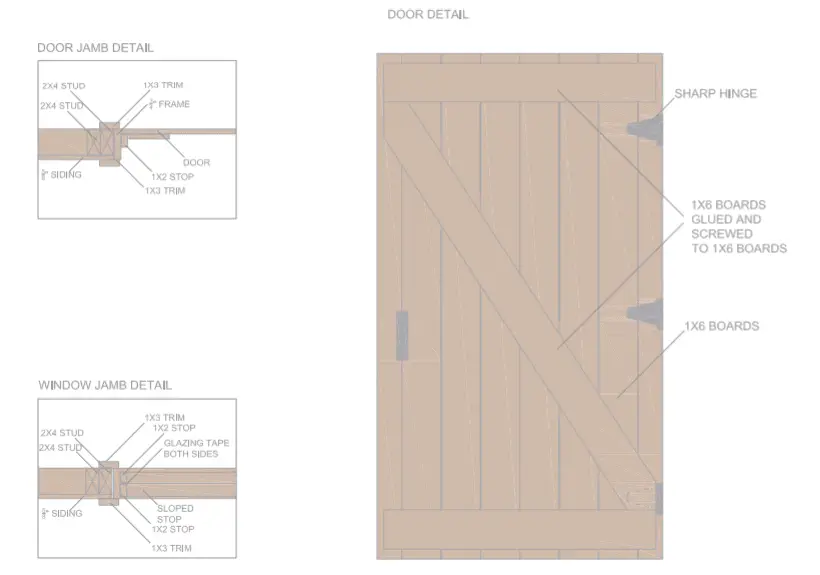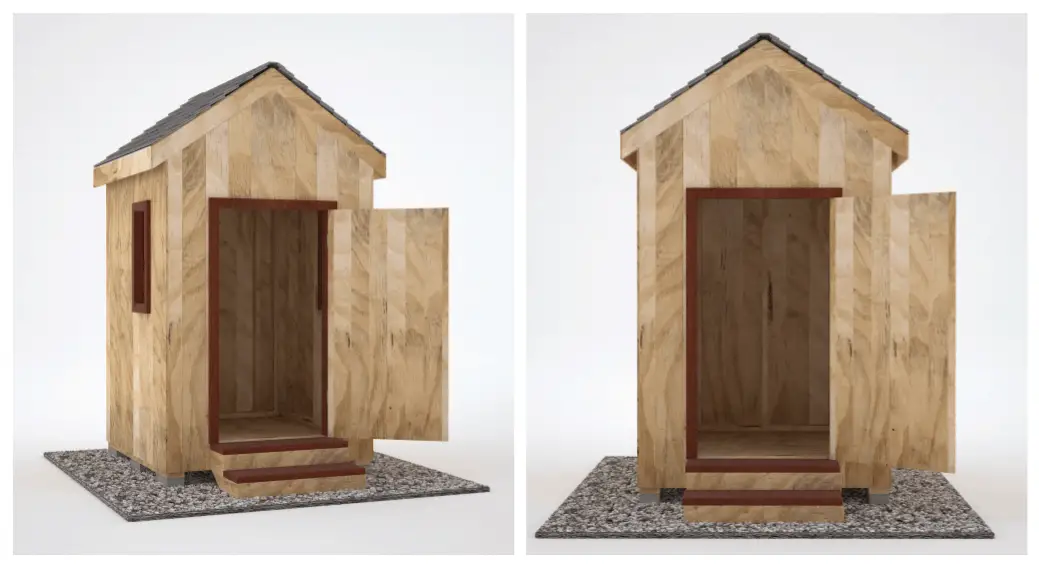6×6 Garden Shed Plans & How to Guide

Quick Navigation
THERE IS SOMETHING ABOUT BUILDING a shed from scratch. It can be more fun, more and you can put your stamp on it. Here is one design can easily be built over the course of a weekend.
Want to Download the Entire Set of 6×6 Shed Plans?
Basics of Shed Building
If you want to build this shed, there are a few things you will need and a few steps you should take before getting started.
Equipment List
The Foundation
Prepared Ground

6x6 Shed Plans - Foundation
No shed is going to last very long if it is not sitting on level ground. Using a spirit level mounted on the side of a 12-foot-long 2×4, check the spot where you plan to place your shed to make sure it's level. One great way to make the spot level is to dig out the grass, loose the soil and then tamp it down checking constantly for level.
What goes under your shed is up to you. You can cover the area in pea gravel, pour a concrete slab, or use paving stones to create a solid foundation. The one thing you don't want to do is place your shed on bare soil as this will invite rot, water damage, and numerous pests to destroy your shed. Remember the best building in the world is only as good as the foundation it is sitting on.
Building the Floor Frame

6x6 Shed Plans - Floor Framing

6x6 Shed Plans - Floor Plan
The floor frame is essentially a box frame with joists inside of it to provide support for the flooring.
- Build the outer frame by laying out the lumber in a square. Use a carpenter's to ensure that all four corners are perfectly square.
- Screw the corners together.
- Measure the inside of the square, and space out the joists evenly before screwing them into place. Be sure to use the carpenter's square to keep all joists perfectly square with the frame.
- Bolt the frame to the mudsills, these will be resting on the foundation and help keep the floor frame out of the mud.
- Cover the floor frame with 3/4-inch plywood sheathing screwed to the frame securely.
Construction
Next Up the Walls

6 x 6 Shed Plans - Side Wall Frame

6 x 6 Shed Plans - Side Wall Front wall
Stick-built walls are built in much the same way as you just built the floor frame, flat on the ground. Each wall is built separately.
- Lay the top and bottom boards in place with the studs set at 18-inches-on-center or evenly spaced along the wall (your choice).
- Using 16d nails assemble the sides in place adding in any window and door headers.
- The walls can then be attached to the floor frame and each other using 16d nails.
- Attach the walls to each other using 16d nails and reinforce the corners using joist clip angles.
At all times when building each wall and when assembling the walls to the floor, be sure to use a level and a square. Building walls that are perfectly perpendicular to the ground and square with each other.
If you don't, building the rest of your shed is going to be that much more difficult. What you may not realize, is that building this shed is not much more (or less for that matter) than building a house. The success of the entire structure depends on the quality of your construction work from start to finish. Take your time at every phase of the construction in order to ensure the success of your project.
Building the Roof

6 x 6 Shed Plans - Roof Plan
The roof you put on your shed will determine how well-protected everything you put inside will be. Built a crappy roof, the rains and snow will destroy it and flood the interior.
- Cut the joists as shown in the diagram, you will need eight of them. Exact measurements are vital here as the angles have to match up perfectly.
- Place the outer end rafters in place along with the ridge boards and nail them in place.
- Install the remaining rafters in place at 2-foot-on-center intervals. Install the two collar ties on the inner rafters.
- Install the 1/2-inch plywood sheathing to the rafters using 8d nails spaced at 10-inch intervals.
- Nail the fascia panels in place using 8d nails spaced at 12-inch intervals.
- Cover with builder's paper or tar paper to help protect the wood.
- Cover with shingles starting at the top of the roof on each side and then work your way down overlapping them as you work your way down.
- Install the ridge shingles, overlapping them from front to back.
While you could stick with tar paper for your roofing material, shingles will give you a much stronger and more weatherproof roof.
Joinery
Doors and Windows

6 x 6 Shed Plans - Door Details
This shed has one door and two windows providing you with easy access and plenty of light and ventilation. Each must be properly framed in for maximum structural integrity.
- Cut the door frame hole out of the siding.
- Install the 2×4 frames in the doorway using 10d nails. Here again, your work needs to be perfect, especially the door frame to ensure the door will open and close smoothly.
- Add the trim around the framework and a doorsill.
- Install the hinges on the door, hold it in place and mark the location of the hinges on the door frame. Have a helper hold the door in place while you screw the hinges to the frame. At this point, double check that the door opens and closes smoothly.
- Cut the window holes out of the siding and frame them in with 2x4s.
- Add the inner stops to the frame and install the glass.
- Secure the glass in place by installing the outer stops.
You can use glass or Plexiglass for your windows. Glass has the added advantage of staying crystal clear and being easy to clean. Plexiglass is much easier to work with and doesn't break, but at the same time, it will yellow and become cloudy over time. Both will keep the rain, snow, dust, debris, thieves, and the local cats out.
Voila One Shed

6x6 shed model render
If you have followed along, by now you should have a complete 6×6 foot shed sitting in your garden and ready to be used. The only thing left for you to do is to decide what color you want it to be. You need to paint your shed in order to protect the wood from Mother Nature. If you don't, the wood will quickly rot and become severely damaged.
Additional Information
- Instead of standard plywood for the wall sheathing, you can use marine plywood or pressure treated lumber. But if you do, you will need to use a saw blade that is designed to cut this type of wood or you risk ruining your saw.
- Nothing is more important than building a solid foundation for your shed. Your best bet is to dig 4 inches down into the ground, loosen the soil, and use a power tamper (you can rent one from your local equipment rental store) to pack it down and level it off.
- The type of foundation you build, gravel and pavers or a poured cement pad is up to you. The most important things are that it is perfectly level and strong enough to support the weight of your shed and everything in it.
- Be sure your foundation pad is at least 12 inches larger all the way around the shed than the outer size of your shed. This will help keep grass from growing up to the side of your shed and causing damage. This will also make it much easier for you mow the lawn. At the same time, building the foundation like this will help keep water from building up around and under your shed where it can cause significant damage to the structure and everything you have inside it.
Want to Download the Entire Set of 6×6 Shed Plans?
Conclusion
The most important thing you can do during the construction of your shed is to make good use of a square and level to ensure your final product is perfectly square. This will ensure all the pieces fit together properly and that the door will function smoothly. Other than this, take your time, being in a hurry typically results in errors being made, many of which can be costly to overcome (i.e. buying more lumber).
Building a 6×6-foot garden shed is something that anyone who is good with tools should be able to do. As with any other type of “stick built” project, I can't stress enough the importance of measuring twice and cutting once. For myself, I measure thrice just to be on the safe side. This shed is easy to build, take your time, have fun, and enjoy the results of your hard work.
If you build this shed I would love to see some photos. You can send them to me here or connect with ZacsGarden on Pinterest or Facebook.
Related Articles:

